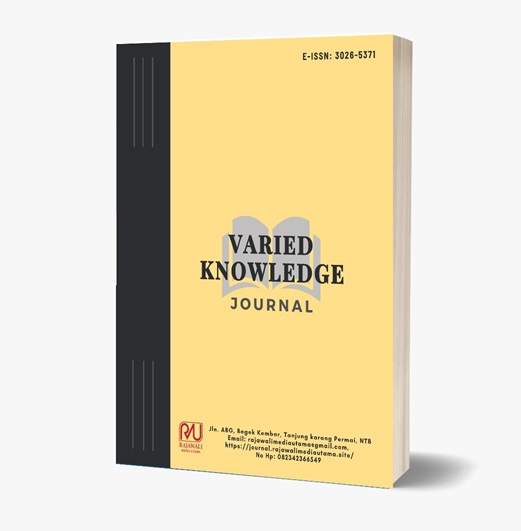Peran Hakim Agung, Metode Berfikir Juridik dan Konsep Keadilan dalam Spirit Reformasi
DOI:
https://doi.org/10.64070/vkj.v1i3.22Keywords:
Supreme Judge, Juridical Thinking Method, Concept of Justice, Spirit of ReformAbstract
This article aims to find out the conception of Justice formulated by the Supreme Judge which is in accordance with the spirit of reform and the juridical-normative thinking method that can be used in formulating the conception of Justice and the role of the Supreme Judge in supporting the realization of legal reform in Indonesia. The type of research used is Normative legal research, normative legal research is research that examines vague norms, conflicting norms and empty norms. Meanwhile, the approach used is a conceptual approach, a statutory approach. The results of this paper show that the concept of justice formed in the Supreme Court's decision is Unity Justice, which is formulated based on: the value of justice that grows and develops in society, the norms of justice and applicable laws and regulations, the interests of achieving the goals of state life, and the interests of the development of community life and the normative juridical thinking method (even coupled with empirical) is not able to formulate complete justice (unity justice), therefore it is added with a holistic and integrative thinking approach and the role of the Supreme Judge in unifying or harmonizing the various dichotomies of the views of the parties that often lead to prolonged forms of conflict through a holistic and integrative approach.
References
Barkun, M. (1972). Law and the social system. New York: Lieber-Atherton, Incorporated.
Bierdtedt, R. (1974). The social order. New York: McGraw-Hill Book & Co.
Bohannan, P. (1967). Law and warfare: Studies in the anthropology of conflict. Austin: University of Texas Press.
Bredermeier, H. C. (1973). Law as an integrative mechanism. In V. Aubert (Ed.), Sociology of law (pp. 17-27). Middlesex: Penguin Books.
Bryant, C. G. A., & Jary, D. (1991). Giddens's theory of structuration: A critical appreciation. London: Routledge.
Cohen, M. R. (1967). Law and the social order: Essays in legal philosophy. Archon Books.
Craib, I. (1984). Modern social theory: From Parsons to Habermas (Edisi Indonesia). Jakarta: Rajawali.
Dror, Y. (1971). Law and social change. In J. B. Grossman & M. H. Grossman (Eds.), Law and change in modern America (pp. 53-68). Pacific Palisades, CA: Goodyear Publishing, Inc.
Dye, T. R. (1978). Understanding public policy (Edisi ketiga). Englewood Cliffs, NJ: Prentice-Hall, Inc.
Freidman, W. (1967). Legal theory. New York: Columbia University Press.
Freidman, W., & Macaulay, S. (1972). Law and behavioral sciences. Indianapolis, NY: The Bobbs-Merril Company, Inc., Publishers.
Friedman, L. M. (1975). The legal system: A social science perspective. New York: Russell Sage Foundation.
Fuller, L. L. (1968). Anatomy of law. Washington: Friedrich A. Praeger, Publisher.
Geertz, C. (1974). The interpretation of cultures: Selected essays. London: Hutchinson & Co. Publisher Ltd.
Giddens, A. (1985). Capitalism and modern theory: An analysis of the writings of Marx, Durkheim, and Max Weber (Edisi Indonesia). Jakarta: UI-Press.
Hoebel, E. A., & Frost, E. (1976). Cultural and social anthropology. New York: McGraw-Hill Book & Co.
Nasikun. (1974). Sebuah pendekatan untuk mempelajari sistem sosial Indonesia. Yogyakarta: Seksi Penerbitan Fakultas Sosial dan Politik, UGM.
Nonet, P., & Selznick, P. (1978). Law and society in transition: Toward responsive law. New York: Harper Torchbooks, Harper and Row Publisher.
Parsons, T. (1964). The social system. Toronto: A Free Press Paperback.
Rahardjo, S. (1986). Ilmu hukum. Bandung: Alumni.
Ritzer, G. (1989). Contemporary sociological theory (Edisi kedua). New York: Alfred A. Knopf.
Schur, E. M. (1978). Law and society: A sociological view. New York: Random House.
Scott, J. C. (1972). The erosion of patron-client bonds and social change in rural Southeast Asia. Journal of Asian Studies, 32(1), 55-73.
Seidman, R. B. (1978). The state, law, and development. New York: St Martin's Press.
Selznick, P. (1969). Law, society, and industrial justice. New York: Russell Sage Foundation.
Soekanto, S. (1979). Masalah kedudukan dan peranan hukum adat. Jakarta: Academica.
Steward, J. H. (1955). Theory of cultural change. Urbana: University of Illinois Press.
Stone, J. (1969). Law and social science. Minneapolis: University of Minnesota Press.
Trubek, D. M. (1972). Toward a social theory of law. The Yale Journal, 1, 30-49.
Turner, J. H. (1974). The structure of sociological theory. Homewood, IL: The Dorsey Press.
Veerger, K. J. (1985). Realita sosial: Refleksi filsafat sosial atas hubungan individu-masyarakat dalam cakrawala sejarah sosiologi. Jakarta: Gramedia.
Weber, M. (1954). Law in economic and society. Cambridge, MA: Harvard University Press.















